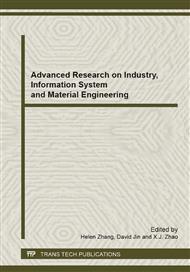[1]
W.D. Zhang, Biogas Fermentation Residues Utilization (Yunnan Science and Technology Press, China 2002).
Google Scholar
[2]
J.G. Zhang, Biogas technology and its application (Chemical Industry Press; Beijing 2005).
Google Scholar
[3]
X.M. Yin, D. Chen and F.C. Zhen : Guang xi agricultural sciences, Vol. 39 (2008) No. 2, p.172.
Google Scholar
[4]
H. Bouallgui, R. BenCheikh, L. Marouani: Bioresource Technology, Vol. 31 (2003).
Google Scholar
[5]
M.R. Al-Masri: Bioresource Technology, Vol. 77 (2001), p.97.
Google Scholar
[6]
Y.P. Li , X.H. He and Y.Y. Zhu: Jour. Of Northwest Sci-Tech Univ. of Agri. And For. (Nat. Sci. Ed. ), Vol. 32 (2004) No. 10, p.89.
Google Scholar
[7]
X.W. Zhang: Journal of Anhui Agri. Sci., Vol. 39 (2011) No. 37, p.10263.
Google Scholar
[8]
Thangavelu R, Palaniswami A and Velazhahan R: Agriculture, Ecosystems and Environment, Vol. 103 (2004) No. 1, p.259.
DOI: 10.1016/j.agee.2003.09.026
Google Scholar
[9]
S.H. Yan, D.Q. Lu and Y.H. Yang: Chinese Journal of Biological Control, Vol. 5 (1999) No. 2, p.97.
Google Scholar
[10]
S.H. Yan, D.Q. Lu and S.Y. Liu: Acta Phytopathologica Sinica, Vol. 31 (2001) No. 3, p.265.
Google Scholar
[11]
S.P. Wu, S.H. Yan and D.Q. Lu: Southwest China Journal of Agricultural Sciences, Vol. 15 (2002) No. 2, p.65.
Google Scholar
[12]
Pérez-Vicente L, Batlle A and Fonseca J: 2nd International symposium on Fusarium Wilt (Banana, 2003). Vol. 9, p.22.
Google Scholar
[13]
Y. Ma, H. Li, Z.Z. Chang and Y.D. Xu: Journal of Agro-Environment Science, Vol. 30 (2011) No. 2, p.336.
Google Scholar
[14]
Thangavelu R: 2nd International symposium on Fusarium Wilt (Banana, 2003). Vol. 9, p.26.
Google Scholar
[15]
L.Q. Chen, R. Guo and D.Q. Lu: Renewable Energy, Vol. 123 (2005) No. 5, p.24.
Google Scholar
[16]
L.Q. Chen, F. Yin and W.D. Zhang: Renewable Energy, Vol. 125 (2003) No. 3, p.22.
Google Scholar
[17]
L.Q. Chen, F. Yin and S.Q. Liu: China Biogas, Vol. 24 (2006) No. 3, p.16.
Google Scholar
[18]
L.Q. Chen, F. Yin and W.D. Zhang: Agriculture&Technology, Vol. 25 (2005) No. 5, p.57.
Google Scholar
[19]
M.Y. Fang Meng-ying, F. Yin and W.D. Zhang: Journal of Yunnan Normal University (natural sciences edition),2011,31(supplement issue): Vol. 30 (2011) No. 2, p.336. 115-118.
Google Scholar


